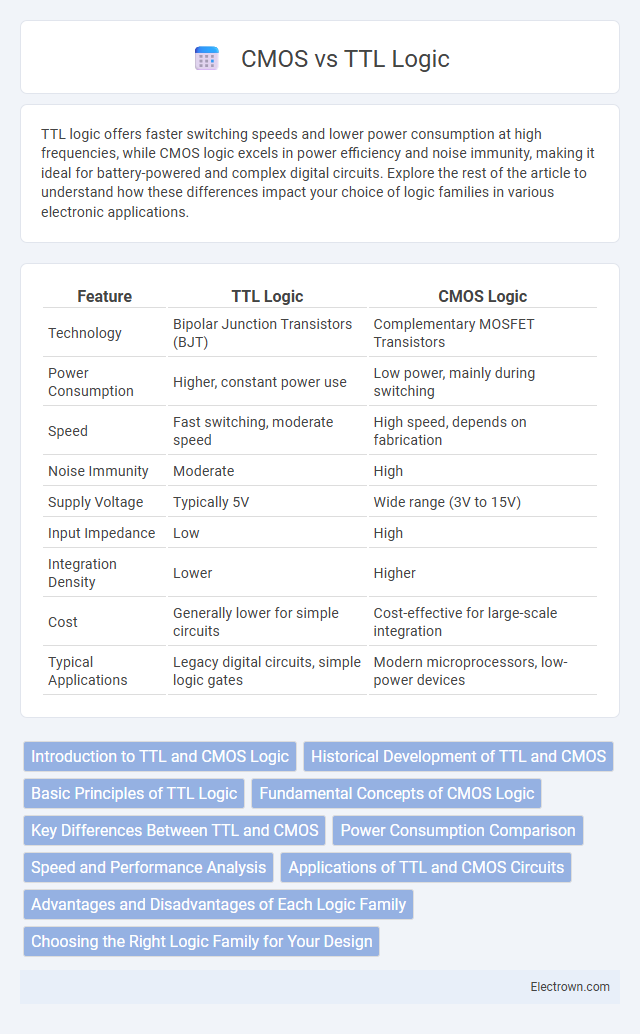TTL logic offers faster switching speeds and lower power consumption at high frequencies, while CMOS logic excels in power efficiency and noise immunity, making it ideal for battery-powered and complex digital circuits. Explore the rest of the article to understand how these differences impact your choice of logic families in various electronic applications.
Table of Comparison
| Feature | TTL Logic | CMOS Logic |
|---|---|---|
| Technology | Bipolar Junction Transistors (BJT) | Complementary MOSFET Transistors |
| Power Consumption | Higher, constant power use | Low power, mainly during switching |
| Speed | Fast switching, moderate speed | High speed, depends on fabrication |
| Noise Immunity | Moderate | High |
| Supply Voltage | Typically 5V | Wide range (3V to 15V) |
| Input Impedance | Low | High |
| Integration Density | Lower | Higher |
| Cost | Generally lower for simple circuits | Cost-effective for large-scale integration |
| Typical Applications | Legacy digital circuits, simple logic gates | Modern microprocessors, low-power devices |
Introduction to TTL and CMOS Logic
TTL (Transistor-Transistor Logic) and CMOS (Complementary Metal-Oxide-Semiconductor) are two fundamental types of digital logic families widely used in electronic circuits. TTL circuits use bipolar junction transistors (BJTs) and are known for faster switching speeds but higher power consumption, while CMOS technology relies on field-effect transistors (FETs) that offer lower power dissipation and greater noise immunity. Understanding the characteristics of TTL versus CMOS logic helps you choose the most efficient technology for your specific digital application.
Historical Development of TTL and CMOS
TTL (Transistor-Transistor Logic) emerged in the 1960s as a dominant digital logic family, known for its fast switching speeds and robust noise immunity, revolutionizing early computer design and industrial electronics. CMOS (Complementary Metal-Oxide-Semiconductor) technology, developed later in the late 1960s and 1970s, gained prominence due to its significantly lower power consumption and high-density integration capabilities, becoming essential in modern microprocessors and memory devices. Your choice between TTL and CMOS depends on factors like power efficiency, switching speed, and integration scale, reflecting their distinct historical evolution and application niches.
Basic Principles of TTL Logic
TTL logic operates using bipolar junction transistors (BJTs) to perform switching functions with high speed and moderate power consumption. Its basic principle relies on transistor-transistor interactions to achieve logic gate operations, where multiple BJTs amplify and switch current to represent binary states. Understanding TTL's transistor-driven mechanism helps you design circuits that require fast switching and reliable logic levels in digital electronics.
Fundamental Concepts of CMOS Logic
CMOS logic operates using complementary pairs of p-type and n-type MOSFETs, which efficiently switch between high and low voltage states to represent binary data. This design drastically reduces power consumption during static operation compared to TTL logic by minimizing leakage current. Your circuits benefit from CMOS's high noise immunity and scalability, making it ideal for modern digital applications.
Key Differences Between TTL and CMOS
TTL (Transistor-Transistor Logic) uses bipolar junction transistors and operates at a typical voltage of 5V with higher power consumption and faster switching speeds, while CMOS (Complementary Metal-Oxide-Semiconductor) relies on complementary p-type and n-type MOSFETs, offering lower power consumption and higher noise immunity. TTL circuits generally have lower input impedance and produce more heat, whereas CMOS circuits exhibit high input impedance, reduced heat dissipation, and wider operating voltage ranges from 3V to 15V. The choice between TTL and CMOS impacts factors such as speed, power efficiency, and signal integrity in digital integrated circuits.
Power Consumption Comparison
CMOS logic circuits consume significantly less power than TTL circuits due to their high input impedance and the absence of current flow in steady states, resulting in minimal static power dissipation. TTL logic gates draw continuous current even when not switching, leading to higher power consumption, especially in large-scale integrations. As a result, CMOS technology is preferred in battery-powered and energy-efficient applications where low power consumption is critical.
Speed and Performance Analysis
TTL logic circuits typically offer faster switching speeds with propagation delays around 1-10 nanoseconds, making them ideal for high-speed applications requiring rapid response times. CMOS logic excels in power efficiency and scalability, presenting slightly slower switching speeds, generally in the range of 10-100 nanoseconds, but with significantly lower power consumption and heat generation. Your choice between TTL and CMOS should consider the trade-off between speed and power efficiency, especially in applications where performance and energy constraints are critical.
Applications of TTL and CMOS Circuits
TTL circuits excel in applications requiring high-speed switching and robust noise immunity, making them ideal for digital systems such as computer logic gates, microprocessors, and industrial control equipment. CMOS circuits dominate battery-powered devices and portable electronics due to their low power consumption and high density integration, including smartphones, sensors, and mixed-signal integrated circuits. Understanding the strengths of TTL and CMOS technologies helps optimize your design choices for energy efficiency, speed, or integration complexity based on application requirements.
Advantages and Disadvantages of Each Logic Family
TTL logic offers faster switching speeds and better noise immunity, making it ideal for high-speed applications, but it consumes more power and has limited fan-out compared to CMOS. CMOS logic excels in low power consumption and higher density integration, beneficial for battery-powered and large-scale circuits, yet it is more susceptible to static discharge and typically slower in switching speed than TTL. Your choice between TTL and CMOS depends on prioritizing speed and noise robustness or power efficiency and integration scale.
Choosing the Right Logic Family for Your Design
Choosing the right logic family, TTL (Transistor-Transistor Logic) or CMOS (Complementary Metal-Oxide-Semiconductor), depends on factors such as power consumption, speed, and noise immunity. TTL offers faster switching speeds and better noise margins, making it ideal for high-speed digital circuits, while CMOS provides lower power consumption and higher density, suitable for battery-operated and large-scale integration designs. Evaluating your application's voltage levels, design complexity, and thermal constraints ensures optimal performance by selecting the appropriate logic family.
TTL vs CMOS logic Infographic

 electrown.com
electrown.com